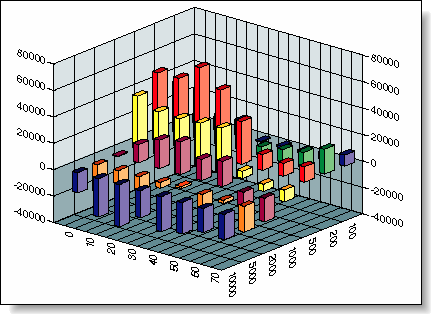MONEY MANAGEMENT
by Jeffrey Owen Katz, Ph.D., and Donna L. McCormick
Last issue, we saw a demonstration of how an exit strategy can affect the performance of a trading system. This time, we will discover how to measure the impact of exiting the market by using trailing-stop techniques.
Previously, we explored the behavior of a simple exit strategy involving a profit target exit, a stop-loss exit and a time-based exit. We used a standardized random entry system in which a random number generator provided us with entries into positions from which we could exit. Our goal was to find out how an exit strategy could improve the performance of a system whose trade entries were essentially random.
This exercise demonstrated that a proper combination of even simple exit methods such as fixed dollar-amount stop-losses and profit targets can substantially improve the behavior of a trading system -- even turning a random, losing system into a profitable one! Employing stop-losses and profit targets of the wrong sizes can ruin a trading system, making it perform significantly worse than it would have otherwise. Finally, although there is some interaction between the entry method and the behavior of the exit strategy, there is also much similarity across entry methods in the behavior of the exits.
This time, we will continue our study of exit strategies by exploring the behavior of trailing stops? in the context of the same standardized, random-entry system.
WHAT TRAILING STOPS ARE
A trailing stop is much like an ordinary stop-loss: It gets you out of a trade when the market moves against you. However, unlike the simple stop-loss order, which usually remains fixed throughout the trade, a trailing stop is repeatedly adjusted as the trade progresses. Trailing stops are used in an attempt to lock in some of the paper profits that could accrue should the market move in the direction desired. Like an ordinary stop, the trailing stop is started at some initial value, but then is moved up (in a long trade) or down (in a short trade) as the market moves in your favor.
The exact setting of the stop can be achieved in a variety of ways. The simplest approach is to place the stop for the next day (or bar) based on a certain dollar-amount retracement relative to the current day's high or low. A better approach is to set the stop based on a percentage of the maximum favorable excursion of the trade so far. In the case of a long trade, one's stop may be placed at 50% of the maximum favorable excursion; as the market moves up, giving you a paper profit, the stop moves up half as quickly, thus locking in 50% of that paper profit. Should the market retrace more than 50% of its movement, you are out of the trade with at least some of your profit intact. Should the market retrace more than 50%, the trend is over and it no longer makes sense to hold the position. The percentage can be whatever you choose it to be, of course.
VARIATIONS ON A THEME
This time, we are going to use a slight variation on this kind of trailing stop. We are going to calculate the stop in the following manner. Assume we have entered the Standard & Poor's 500 index on the open at 1,000 in a long trade. Our money management stop is placed initially at 998; we have a $500 stop-loss. On that first day, the market achieves a high of 1,008 and closes at 1,006. To calculate our stop placement for the next day, we take 1,008 and subtract our baseline stop (998, the original stop), multiply by the percentage factor that we are using (for example, 0.50 or 50%), which gives us 5, and then add that to 998. This gives us a stop value for the second day of 1,003.

Although many combinations of baseline stops and percentage factors improved system performance, many other combinations resulted in serious losses.
Jeffrey Owen Katz, Ph.D., is a professional trader and consultant in Selden, NY. His firm, Scientific Consultant Services Inc. (516 696-3333), specializes in custom programming of trading systems and tools, provides expert consultation on systems development and the use of Omega Research tools, and develops publicly available cutting-edge software for traders. Donna L. McCormick is a writer and vice president of Scientific Consultant Services.